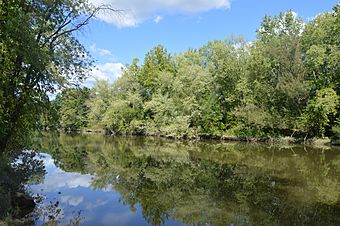Big Bend Historical Area facts for kids
Quick facts for kids |
|
|
Big Bend Historical Area
|
|

Along the river at the site of Big Bend
|
|
| Location | 6 miles (9.7 km) northwest of Mercer on the Shenango River, Jefferson Township, Pennsylvania |
|---|---|
| Area | 204 acres (83 ha) |
| Built | 1846 |
| NRHP reference No. | 75001654 |
| Added to NRHP | April 21, 1975 |
The Big Bend Historical Area is a special place in Jefferson Township, Mercer County, Pennsylvania. It's a national historic district that protects important old sites. This area is found along the Shenango River. It tells the story of a small village that once thrived here.
This historic district includes four main sites and two structures. These are spread across three different spots along the river. It's where the old Village of Big Bend used to be. This village was abandoned before 1940. The area also holds the remains of an old iron furnace and parts of a historic canal.
The Big Bend Historical Area was added to the National Register of Historic Places in 1975. This means it's recognized as a very important place in American history.
Contents
Exploring the Big Bend Historical Area
The Big Bend Historical Area is like a giant outdoor museum. It shows us what life was like in the early 1800s. You can see clues about how people lived and worked here long ago.
The Lost Village of Big Bend
Imagine a busy little village that disappeared! That's what happened to the Village of Big Bend. It was a small community that grew up around the river and the canal. People lived and worked here, but over time, the village was abandoned. Today, you can explore the land where it once stood.
The Big Bend Iron Furnace
One of the most important parts of this area is the site of the Big Bend Iron Furnace. This furnace was built in 1846. It was a huge structure used to make iron. Iron was very important back then for building tools, machines, and even parts of canals.
The furnace would melt iron ore using heat from burning charcoal. This process created "pig iron," which was then used to make other iron products. The Big Bend Iron Furnace played a big role in the local economy. It provided jobs and helped the region grow. Today, you can see the remains of this old industrial site.
The Erie Extension Canal's Story
The Shenango Division of the Erie Extension Canal was a vital waterway. It was like an old highway made of water. Canals were used to transport goods and people across long distances. They were especially important before railroads became common.
At Big Bend, you can still find parts of this old canal. Look for the towpath, which was a path alongside the canal. Mules or horses would walk on the towpath. They pulled boats loaded with goods through the water. You can also see the remains of a loading bay. This is where boats would stop to load or unload their cargo. There was also a road that connected to the canal.
Canal Locks and Dams
Canals often needed special structures to help boats travel up or down hills. These were called locks. A lock is like a water elevator for boats. It uses gates to raise or lower the water level. This allows boats to move between different heights of water.
At Big Bend, you can find the remains of Dam Number 2. Dams helped control the water level in the canal. There are also signs of a canal lock. Near the lock, there was a lockkeeper's house. The lockkeeper was the person who operated the lock gates. They lived right there to make sure boats could pass through safely.
The Shenango House Hotel
Around 1830, a place called the Shenango House Hotel stood in this area. Hotels were important stops for travelers. People using the canal or traveling by road would stay there. It was a place for rest, food, and news. While the hotel is no longer standing, its site is part of the historical area. It reminds us of the people who passed through this busy spot long ago.
What You Can See Today
Today, the Big Bend Historical Area is a quiet place. It's a great spot to explore history and nature. You can walk along the old towpath and imagine boats floating by. You can see the foundations of the iron furnace and other structures. These remains are like clues from the past. They help us understand how people lived and worked in this part of Pennsylvania. It's a perfect place for a historical adventure!



